老托福听力30篇下载之实验(原文+翻译)
- 格式:docx
- 大小:80.86 KB
- 文档页数:1
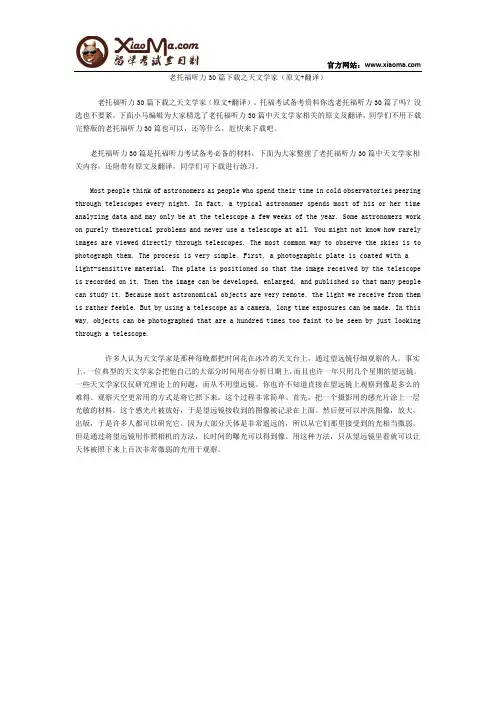
官方网站:老托福听力30篇下载之天文学家(原文+翻译)老托福听力30篇下载之天文学家(原文+翻译)。
托福考试备考资料你选老托福听力30篇了吗?没选也不要紧,下面小马编辑为大家精选了老托福听力30篇中天文学家相关的原文及翻译,同学们不用下载完整版的老托福听力30篇也可以,还等什么,赶快来下载吧。
老托福听力30篇是托福听力考试备考必备的材料,下面为大家整理了老托福听力30篇中天文学家相关内容,还附带有原文及翻译,同学们可下载进行练习。
Most people think of astronomers as people who spend their time in cold observatories peering through telescopes every night. In fact, a typical astronomer spends most of his or her time analyzing data and may only be at the telescope a few weeks of the year. Some astronomers work on purely theoretical problems and never use a telescope at all. You might not know how rarely images are viewed directly through telescopes. The most common way to observe the skies is to photograph them. The process is very simple. First, a photographic plate is coated with a light-sensitive material. The plate is positioned so that the image received by the telescope is recorded on it. Then the image can be developed, enlarged, and published so that many people can study it. Because most astronomical objects are very remote, the light we receive from them is rather feeble. But by using a telescope as a camera, long time exposures can be made. In this way, objects can be photographed that are a hundred times too faint to be seen by just looking through a telescope.许多人认为天文学家是那种每晚都把时间花在冰冷的天文台上,通过望远镜仔细观察的人。
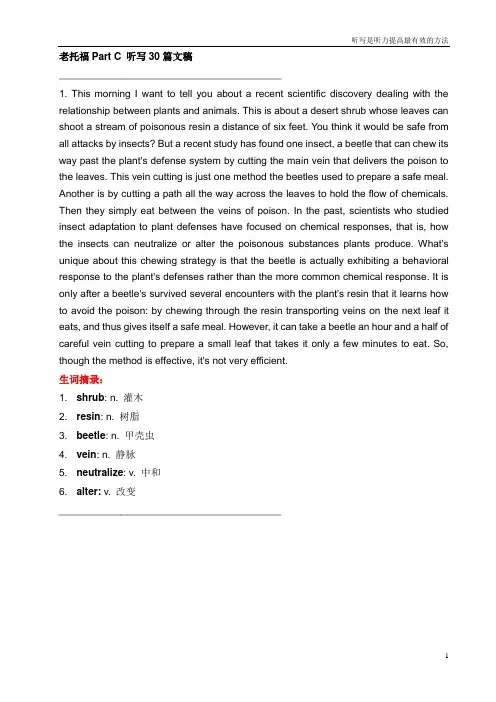
老托福Part C 听写30篇文稿________________________________________1. This morning I want to tell you about a recent scientific discovery dealing with the relationship between plants and animals. This is about a desert shrub whose leaves can shoot a stream of poisonous resin a distance of six feet. You think it would be safe from all attacks by insects? But a recent study has found one insect, a beetle that can chew its way past the plant's defense system by cutting the main vein that delivers the poison to the leaves. This vein cutting is just one method the beetles used to prepare a safe meal. Another is by cutting a path all the way across the leaves to hold the flow of chemicals. Then they simply eat between the veins of poison. In the past, scientists who studied insect adaptation to plant defenses have focused on chemical responses, that is, how the insects can neutralize or alter the poisonous substances plants produce. What's unique about this chewing strategy is that the beetle is actually exhibiting a behavioral response to the plant's defenses rather than the more common chemical response. It is only after a beetle's survived several encounters with the plant's resin that it learns how to avoid the poison: by chewing through the resin transporting veins on the next leaf it eats, and thus gives itself a safe meal. However, it can take a beetle an hour and a half of careful vein cutting to prepare a small leaf that takes it only a few minutes to eat. So, though the method is effective, it's not very efficient.生词摘录:1. shrub: n. 灌木2. resin: n. 树脂3. beetle: n. 甲壳虫4. vein: n. 静脉5. neutralize: v. 中和6. alter: v. 改变________________________________________2. Human populations near the equator have evolved dark skin over many generations because of exposure to the fiercest rays of the sun. A similar phenomenon has also occurred in other parts of the animal kingdom. The African grass mouse is a good example. Most mice are nocturnal, but the African grass mouse is active during daylight hours. This means that it spends its days searching for food in the semi-dry bush in scrubby habitats of eastern and southern Africa. Its furry stripe's like a chipmunk's, which helps it blend in with its environment. Because it spends a lot of time in the intense tropical sun, the grass mouse has also evolved two separate safeguards against the sun's ultraviolet radiation. First, like the population of humans in this region of the world, the skin of the grass mouse contains lots of melanin, or dark pigment. Second and quite unusual, this mouse has a layer of melanin-pigmented tissue between its skull and skin. This unique cap provides an extra measure of protection for the grass mouse and three other types of African mouse, like rodents that are active during the day. The only other species scientists has identified with the same sort of skull adaptation is the white tent-making bat of the Central American tropics. Although these bats sleep during the day, they do so curled up with their heads exposed to the sun.生词摘录:1.equator: n. 赤道2.nocturnal: adj. 夜行的3.scrubby: adj. 树丛繁盛的4.stripe: n. 条纹5.chipmunk: n. 花栗鼠6.ultraviolet: adj. 紫外线的7.melanin: n. 黑色素8.pigment: n. 色素9.rodent: n. 啮齿类动物10.skull: n. 头骨________________________________________3. We've been looking at fear from a biological perspective, and someone asked whether the tendency to be fearful is genetic. What some studies done with mice indicate that mammals do inherit fearfulness to some degree. In one study, for instance, a group of mice was placed in a brightly lit open box with no hiding places. Some of the mice wandered around the box and didn't appear to be bothered about being so exposed. But other mice didn't move. They stayed up against one wall which indicated that they were afraid. Well, when fearful mice, or you might say anxious mice like the ones who stayed in one place, when mice like these were bred with one another repeatedly, after about twelve or so generations, then all of the offspring showed similar signs of fearfulness. And even when a new born mouse from this generation was raised by a mother and with other mice who were not fearful, that mouse still tended to be fearful as an adult. Now why is this? Well it's thought that specific genes in an animal's body have an influence on anxious behavior. These are genes that are associated with particular nerve-cell receptors in the brain. And the degree of overall of fearfulness in the mammal seems to depend in large part on the presence or absence of these nerve-cell receptors. And this appears to apply to humans as well by the way. But while a tendency towards anxiety and fear may well be an inherited trait, the specific form that the fear takes has more to do with the individual's environment. So a particular fear, like the fear of snakes or the fear of spider, say, is not genetic, but the overall tendency to have fearful responses, is. 生词摘录:1. genetic: adj. 遗传的2. offspring: n. 子孙,后代3. receptor: n. 接受器________________________________________4. Let's turn our focus now to advertising. We all know what an advertisement is. It's essentially a message that announces something for sale. Now there's an important precondition that must exist before you have advertising, and that's a large supply of consumer goods, that is, things to sell. You see in a place where the demand for a product is greater than the supply, there is no need to advertise. Now the earliest forms of advertising going back many hundreds of years with a simple sign over shop doors that told you whether the shop was a bakery, a butcher shop or what have you. Then with the advent of printing press, advertising increased substantially. Ads for products like coffee, tea and chocolate appeared in newspapers and other periodicals, as well as on the sides of building. In the American colonies, advertising and communications media like newspapers and pamphlets became a major factor in marketing goods and services. By modern standards, these early advertisements were quite small and subdued, not as splashy, whole page spread of today. Still some of them appeared on the front pages of newspapers probably because the news often consisted of less refresh reports from distant Europe while the ads were current and local. Advertising really came and do it so and became an essential part of doing business during the industrial revolution. Suddenly there was a much greater supply of things to sell. And as we said earlier, that is the driving force behind advertising. People's attention had to be drawn to the new product. Let's take a look at some of the advertisements from that time.生词摘录:1. essentially: adv. 本质上,本来2. precondition: n. 先决条件3. bakery: n. 面包店4. butcher: n. 屠户5. periodical: n. 期刊6. pamphlet: n. 小册子7. subdued: adj. 被抑制的8. splashy: adj. 大而显眼的,引人注目的________________________________________5. Moving away from newspapers, let's now focus on magazines. Now, the first magazine was a little periodical called The Review, and it was started in London in 1704. It looked a lot like the newspapers of the time. But in terms of its content, it was much different. Newspapers were concerned mainly with news events, but The Review focused on important domestic issues of the day as well as the policies of the government. Now in England at the time, people could still be thrown in jail for publishing articles that were critical of the king. And that's what happened to Daniel Defoe. He was the outspoken founder of The Review. Defoe actually wrote the first issue of The Review from prison. You see, he had been arrested because of his writings that criticized the policies of the Church of England, which was headed by the king. After his release, Defoe continued to produce The Review and magazine started to appear on a more frequent schedule, about three times a week, it didn't take long for other magazines to start popping up. In 1709, a magazine called The Tatler began publication. This new magazine contained a mixture of news, poetry, political analysis, and philosophical essays.生词摘录:1. periodical: n. 期刊2. The Review: 《评论》杂志3. Daniel Defoe: 丹尼尔·笛福(1660 -1731),生于伦敦一小工商业者家庭,1731年4月26日卒于莫尔福德。

TPO30 R-3 原文翻译The Invention of the Mechanical Clock 在欧洲,在机械表被引入以前,人们利用太阳(比如棍子的影子和日晷)和水来确定时间。
当然,太阳钟表只能用于晴天,而水钟表在水温下降到冻结的时候会出错,会出现没有任何长期漂浮的东西会出现漂浮或者堵塞。
这两种仪器在阳光充裕的气候都运行的很好,但在北欧,太阳可能会藏在云后长达一周,同时,温度不仅会在季节中变化,也会从早到晚的变化。
中世纪欧洲使得可靠的时间变得更重要。
天主教堂有每天七次的祷告,有一个是在晚上,它要求了闹钟的设定,在傍晚前叫醒布道师。
另外新的城市和城镇,由于其空间的限制,他们必须要知道并且安排时间去组织集体活动和分配空间。
他们设定时间去睡觉。
所有这些用老的仪器都是可以一致的,只要只有一个权威的时间记录者。
但是随着城市的发展和报时信号的倍增,时差导致了不和与争吵。
社会需要一个更加可靠的工具去衡量时间,这个仪器就是机械钟表了。
我们并不知道是谁发明了这个机器,或者在哪。
它好像是出现在意大利或是英国(也许是同时发明的)在1275年到1300之间。
一旦被人们所知,它就传播的非常快,人们不再使用水钟表,但日晷依然存在,并被用来对照这个新仪器与原来所用最后一种计时法。
这个早期的版本是基本的,不准确的,并且有崩溃的倾向。
讽刺的是,新仪器有破坏天主教堂权威性的倾向。
虽然教堂仪式一直保持着对时间记录的兴趣贯穿整个城市瓦解跟随着罗马没落的世纪,教堂时间是自然的时间。
白天和黑夜被分为均等的部分,所以除去昼夜平分点,白天和黑夜时间是不均等的;当然因此,这些时间的长度也随着季节变化。
但是,机械时钟保持了均等的小时,这意味着新的时间计算法。
天主教天反抗,将近一个世纪不肯转化到新的时间。
但从一开始,城镇和城市接受了均等时间作为他们的标准,并且安装公共的时钟在城镇大楼和市场变成了新的世俗市政权威的标志。
每个城镇都想要一个;胜利者视它们为珍贵的战利品,在游人去神圣遗骸朝圣的路上,他们专程去看并听这些钟表。
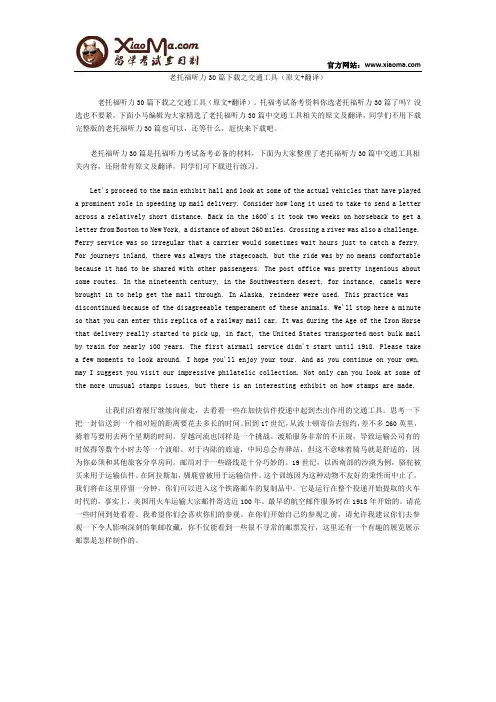
官方网站:老托福听力30篇下载之交通工具(原文+翻译)老托福听力30篇下载之交通工具(原文+翻译)。
托福考试备考资料你选老托福听力30篇了吗?没选也不要紧,下面小马编辑为大家精选了老托福听力30篇中交通工具相关的原文及翻译,同学们不用下载完整版的老托福听力30篇也可以,还等什么,赶快来下载吧。
老托福听力30篇是托福听力考试备考必备的材料,下面为大家整理了老托福听力30篇中交通工具相关内容,还附带有原文及翻译,同学们可下载进行练习。
Let's proceed to the main exhibit hall and look at some of the actual vehicles that have played a prominent role in speeding up mail delivery. Consider how long it used to take to send a letter across a relatively short distance. Back in the 1600's it took two weeks on horseback to get a letter from Boston to New York, a distance of about 260 miles. Crossing a river was also a challenge. Ferry service was so irregular that a carrier would sometimes wait hours just to catch a ferry. For journeys inland, there was always the stagecoach, but the ride was by no means comfortable because it had to be shared with other passengers. The post office was pretty ingenious about some routes. In the nineteenth century, in the Southwestern desert, for instance, camels were brought in to help get the mail through. In Alaska, reindeer were used. This practice was discontinued because of the disagreeable temperament of these animals. We'll stop here a minute so that you can enter this replica of a railway mail car. It was during the Age of the Iron Horse that delivery really started to pick up, in fact, the United States transported most bulk mail by train for nearly 100 years. The first airmail service didn't start until 1918. Please take a few moments to look around. I hope you'll enjoy your tour. And as you continue on your own, may I suggest you visit our impressive philatelic collection. Not only can you look at some of the more unusual stamps issues, but there is an interesting exhibit on how stamps are made.让我们沿着展厅继续向前走,去看看一些在加快信件投递中起到杰出作用的交通工具。
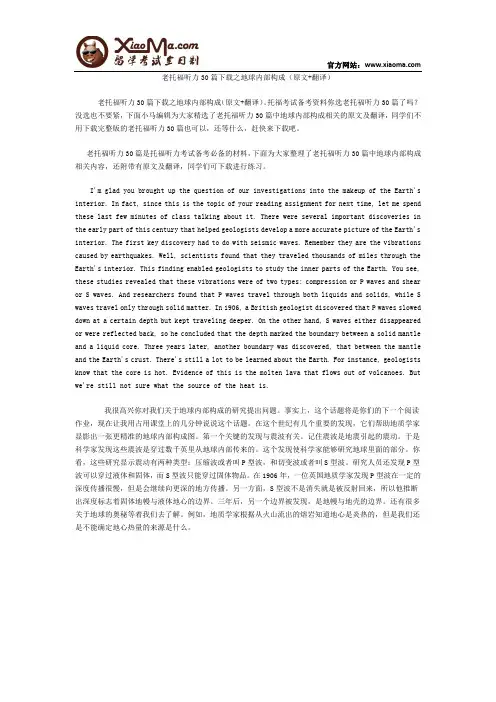
官方网站:老托福听力30篇下载之地球内部构成(原文+翻译)老托福听力30篇下载之地球内部构成(原文+翻译)。
托福考试备考资料你选老托福听力30篇了吗?没选也不要紧,下面小马编辑为大家精选了老托福听力30篇中地球内部构成相关的原文及翻译,同学们不用下载完整版的老托福听力30篇也可以,还等什么,赶快来下载吧。
老托福听力30篇是托福听力考试备考必备的材料,下面为大家整理了老托福听力30篇中地球内部构成相关内容,还附带有原文及翻译,同学们可下载进行练习。
I'm glad you brought up the question of our investigations into the makeup of the Earth's interior. In fact, since this is the topic of your reading assignment for next time, let me spend these last few minutes of class talking about it. There were several important discoveries in the early part of this century that helped geologists develop a more accurate picture of the Earth's interior. The first key discovery had to do with seismic waves. Remember they are the vibrations caused by earthquakes. Well, scientists found that they traveled thousands of miles through the Earth's interior. This finding enabled geologists to study the inner parts of the Earth. You see, these studies revealed that these vibrations were of two types: compression or P waves and shear or S waves. And researchers found that P waves travel through both liquids and solids, while S waves travel only through solid matter. In 1906, a British geologist discovered that P waves slowed down at a certain depth but kept traveling deeper. On the other hand, S waves either disappeared or were reflected back, so he concluded that the depth marked the boundary between a solid mantle and a liquid core. Three years later, another boundary was discovered, that between the mantle and the Earth's crust. There's still a lot to be learned about the Earth. For instance, geologists know that the core is hot. Evidence of this is the molten lava that flows out of volcanoes. But we're still not sure what the source of the heat is.我很高兴你对我们关于地球内部构成的研究提出问题。
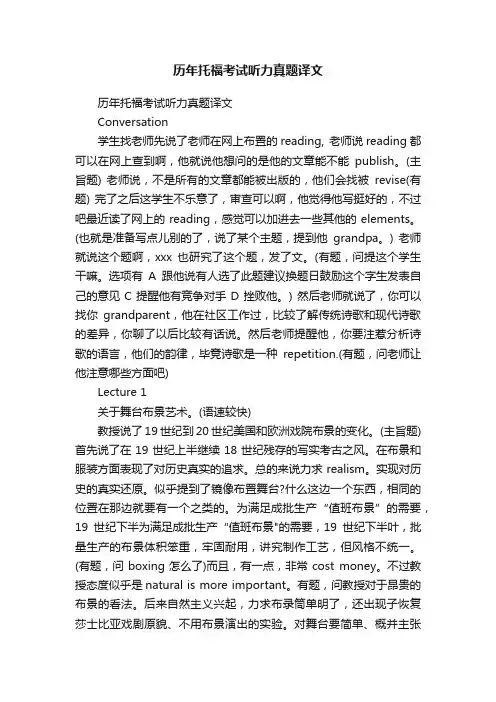
历年托福考试听力真题译文历年托福考试听力真题译文Conversation学生找老师先说了老师在网上布置的reading, 老师说reading都可以在网上查到啊,他就说他想问的是他的文章能不能publish。
(主旨题) 老师说,不是所有的文章都能被出版的,他们会找被revise(有题) 完了之后这学生不乐意了,审查可以啊,他觉得他写挺好的,不过吧最近读了网上的reading,感觉可以加进去一些其他的elements。
(也就是准备写点儿别的了,说了某个主题,提到他grandpa。
) 老师就说这个题啊,xxx也研究了这个题,发了文。
(有题,问提这个学生干嘛。
选项有A跟他说有人选了此题建议换题日鼓励这个字生发表自己的意见C提醒他有竞争对手D挫败他。
) 然后老师就说了,你可以找你grandparent,他在社区工作过,比较了解传统诗歌和现代诗歌的差异,你聊了以后比较有话说。
然后老师提醒他,你要注惹分析诗歌的语言,他们的韵律,毕竟诗歌是一种repetition.(有题,问老师让他注意哪些方面吧)Lecture 1关于舞台布景艺术。
(语速较快)教授说了19世纪到20世纪美国和欧洲戏院布景的变化。
(主旨题)首先说了在19世纪上半继续18世纪残存的写实考古之风。
在布景和服装方面表现了对历史真实的追求。
总的来说力求realism。
实现对历史的真实还原。
似乎提到了镜像布置舞台?什么这边一个东西,相同的位置在那边就要有一个之类的。
为满足成批生产“值班布景”的需要,19世纪下半为满足成批生产“值班布景"的需要,19世纪下半叶,批量生产的布景体积笨重,牢固耐用,讲究制作工艺,但风格不统一。
(有题,问boxing怎么了)而且,有一点,非常cost money。
不过教授态度似乎是natural is more important。
有题,问教授对于昂贵的布景的看法。
后来自然主义兴起,力求布录筒单明了,还出现子恢复莎士比亚戏剧原貌、不用布景演出的实验。
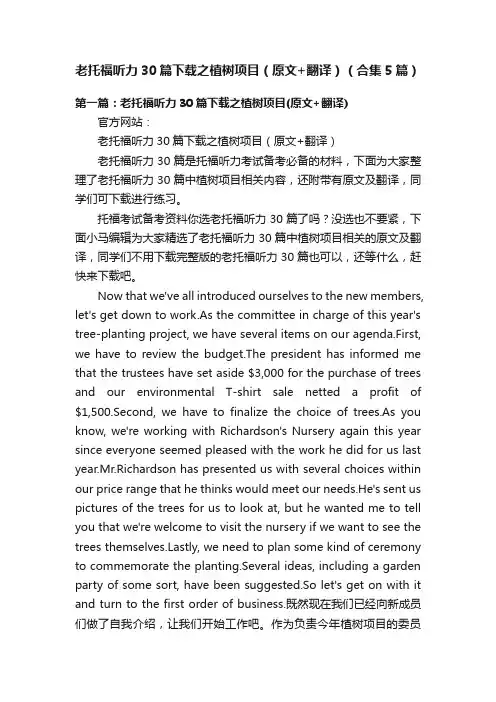
老托福听力30篇下载之植树项目(原文+翻译)(合集5篇)第一篇:老托福听力30篇下载之植树项目(原文+翻译)官方网站:老托福听力30篇下载之植树项目(原文+翻译)老托福听力30篇是托福听力考试备考必备的材料,下面为大家整理了老托福听力30篇中植树项目相关内容,还附带有原文及翻译,同学们可下载进行练习。
托福考试备考资料你选老托福听力30篇了吗?没选也不要紧,下面小马编辑为大家精选了老托福听力30篇中植树项目相关的原文及翻译,同学们不用下载完整版的老托福听力30篇也可以,还等什么,赶快来下载吧。
Now that we've all introduced ourselves to the new members, let's get down to work.As the committee in charge of this year's tree-planting project, we have several items on our agenda.First, we have to review the budget.The president has informed me that the trustees have set aside $3,000 for the purchase of trees and our environmental T-shirt sale netted a profit of $1,500.Second, we have to finalize the choice of trees.As you know, we're working with Richardson's Nursery again this year since everyone seemed pleased with the work he did for us last year.Mr.Richardson has presented us with several choices within our price range that he thinks would meet our needs.He's sent us pictures of the trees for us to look at, but he wanted me to tell you that we're welcome to visit the nursery if we want to see the trees stly, we need to plan some kind of ceremony to commemorate the planting.Several ideas, including a garden party of some sort, have been suggested.So let's get on with it and turn to the first order of business.既然现在我们已经向新成员们做了自我介绍,让我们开始工作吧。
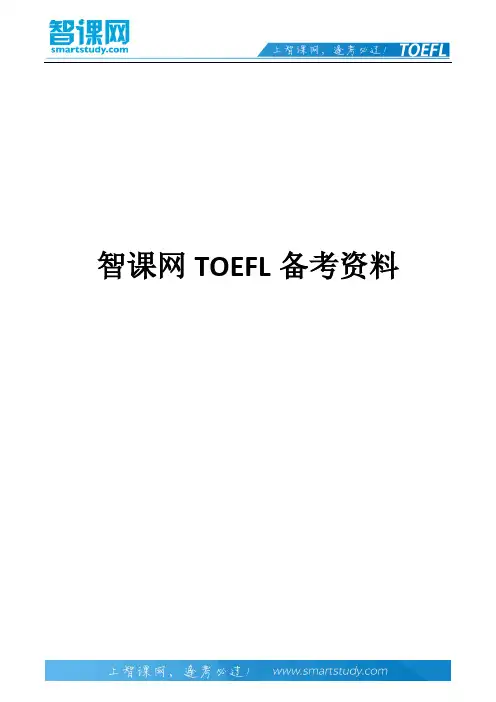
智课网TOEFL备考资料老托福听力93篇下载(文本+翻译)摘要:老托福听力93篇下载(文本+翻译)!托福听力要想拿到高分,必然就要勤加苦练。
其实听力方面真的没有特别的技巧,因此大家考试回归到苦练上吧,接下来就让我们练习老托福听力93篇吧!老托福听力93篇是练习听力的常见资料,利用老托福真题的练习,可以让大家更加清晰的了解托福听力考试,更加熟悉的了解托福听力的题型等等。
老托福听力93篇生词预习:1. stylized: adj. drawn or written in an artificial style, that does not include natural detail(绘画或写作)程式化的2. realism: n.[U]the style of art and literature in which everything is shown or described as it really is in life 现实主义,写实主义(艺术、文学上的风格)3. portrait: n.[C]a painting, drawing, or photograph of a person(人的)画像;照片;肖像[+of]4. imitate: v. to copy something because you think it is good(认为是好的因而)仿效(某物)5. static: adj. not moving, changing, or developing, especially when movement or change would be good 不动的;不变化的;不发展的;静(止)的6. formalism: n.[U]a style or method in art, religion, or science that pays too much attention to established rules(艺术、宗教或科学的)形式主义...扫码安装小马 APP,免费在线练习老托福听力93篇老托福听力93篇文本:Before we begin our tour, I'd like to give you some background information on the painter Grant Wood. We’ll be seeing much of his work today. Wood was born in 1881 in Iowa farm country, and became interested in art very early in life. Although he studied art in both Minneapolis and at the Art Institute of Chicago, the strongest influences on his art were European. He spent time in both Germany and France and his study there helped shape his own stylized form of realism. When he returned to Iowa, Wood applied the stylistic realism he had learned in Europe to the rural life he saw around him and that he remembered from his childhood around the turn of the century. His portraits of farm families imitate the static formalism of photographs of early settlers posed in front of their homes. His paintings of farmers at work, and of their tools and animals, demonstrate a serious respect for the life of the Midwestern United States. By the 1930's, Wood was a leading figure of the school of art called "American regionalism." In an effort to sustain a strong Midwestern artistic movement, Wood established an institute of Midwestern art in his home state. Although the institute failed, the paintings you are about to see preserve Wood's vision of pioneer farmers....以上就是整理的“老托福听力93篇下载(文本+翻译)”,希望通过这些听力真题的练习,能够帮助大家更好的来备考托福考试 !相关字搜索:老托福听力93篇。
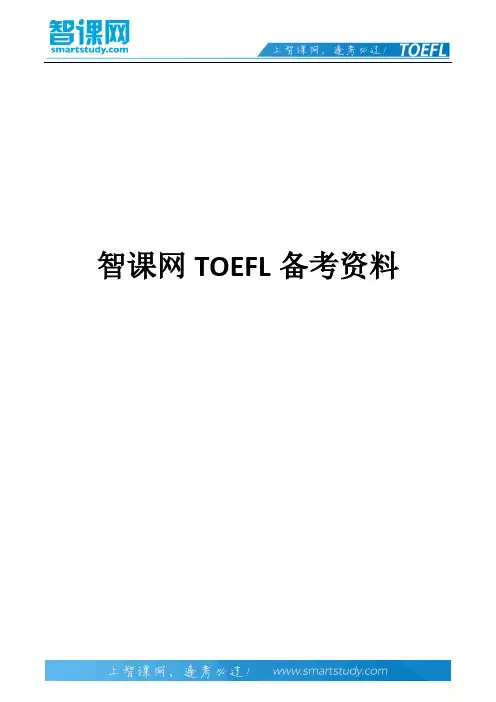
智课网TOEFL备考资料托福TPO1-30听力原文文本全集18 版整理摘要:托福TPO听力1-30听力原文文本全集1.8 版整理!大家都知道托福听力TPO试题都来源于历年考试机经,对于该试题内容的权威性和仿真性自不用说,为方便大家更深入的研究小编特给出了托福TPO听力1-30听力原文文本全集1.8 版资料,同学们可以好好练习一下。
托福 TPO听力1-30听力原文文本全集1.8 版整理!大家都知道托福听力 TPO试题都来源于历年考试机经,对于该试题内容的权威性和仿真性自不用说,为方便大家更深入的研究小编特给出了托福TPO听力1-30听力原文文本全集1.8 版资料,同学们可以好好练习一下。
1.Why does the student go to see the librarian? #To sign up for a seminar on using electronic sources for research #To report that a journal is missing from the reference area #To find out the procedure for checking out journal articles #To ask about how to look for resources for a class paper #2.What does the librarian say about the availability of journals and articles in the library? #They are not easy to find if a professor put them on reserve #Most of them are accessible in an electronic format #Most of them can be checked out for three weeks #Printed versions from the past three years are located in the reference section #3.What does the librarian suggest the student should do to save time? #Choose an easier research topic#Concentrate on five journals#Read the summaries of the articles first#Install a new program on her home computer#4.What can be inferred about why the woman decides to use the computer in the library?#She thinks she might need additional help from the man#She does not have a computer at home#She has to hand in her assignment by the end of the day#She will be meeting a friend in the library later on#5.Why does the woman say this #She had forgotten about the information#She is surprised she was not aware of the information#She is annoyed that the information was published only recently#She is concerned that the librarian gave her incorrect information针对大家托福听力提分困难的复习处境,小马有开发出模拟托福听力考场环境的托福听力APP,小马托福听力APP中涵盖了TPO1-34听力真题全部内容的,答案解析应有尽有。

官方网站:老托福听力30篇下载之James Polk(原文+翻译)老托福听力30篇是托福听力考试备考必备的材料,下面为大家整理了老托福听力30篇中James Polk 相关内容,还附带有原文及翻译,同学们可下载进行练习。
托福考试备考资料你选老托福听力30篇了吗?没选也不要紧,下面小马编辑为大家精选了老托福听力30篇中James Polk相关的原文及翻译,同学们不用下载完整版的老托福听力30篇也可以,还等什么,赶快来下载吧。
So, uh . . . as Jim said, James Polk was the eleventh President, and . . . uh . . . well, my report's about the next President—Zachary Taylor. Taylor was elected in 1849. It's surprising because . . . well, he was the first President that didn't have any previous political experience. The main reason he was chosen as a candidate was because he was a war hero. In the army, his men called him "Old Rough and Ready". I guess because of his . . . "rough edges." He was kind of blunt and he didn't really look like a military hero. He liked to do things like wear civilian clothes instead of a uniform, even in battle. And he was so short and plump he had to be lifted up onto his horse.But he did win a lot of battles and he became more and more popular. So, the Whig party decided to nominate him for the presidency, even though no one knew anything about where he stood on the issues. I couldn't find much about his accomplishments, probably because he was only in office about a year and a half before he died. But one thing, he pushed for the development of the transcontinental railroad because he thought it was important to form a link with the West Coast. There was a lot of wealth in California and Oregon from commerce and minerals and stuff. Also, he established an agricultural bureau in the Department of the Interior and promoted more government aid to agriculture. Well, that's about all I found. Like I said, he died in office in 1850, so his Vice President took over, and that's the next report, so . . . thank you.所以,嗯…就像Jim所说,James Polk是第11任总统,并且…嗯…好了,我的报告时关于下一任总统——Zachary Taylor。
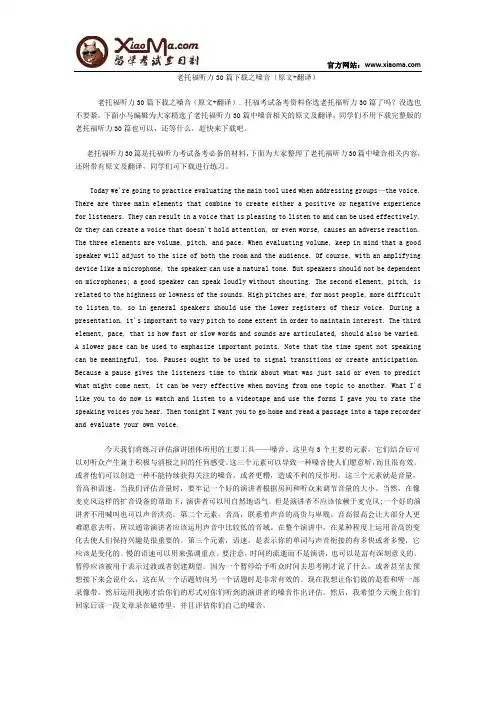
老托福听力30篇下载之嗓音(原文+翻译)老托福听力30篇下载之嗓音(原文+翻译)。
托福考试备考资料你选老托福听力30篇了吗?没选也不要紧,下面小马编辑为大家精选了老托福听力30篇中嗓音相关的原文及翻译,同学们不用下载完整版的老托福听力30篇也可以,还等什么,赶快来下载吧。
老托福听力30篇是托福听力考试备考必备的材料,下面为大家整理了老托福听力30篇中嗓音相关内容,还附带有原文及翻译,同学们可下载进行练习。
Today we're going to practice evaluating the main tool used when addressing groups—the voice. There are three main elements that combine to create either a positive or negative experience for listeners. They can result in a voice that is pleasing to listen to and can be used effectively. Or they can create a voice that doesn't hold attention, or even worse, causes an adverse reaction. The three elements are volume, pitch, and pace. When evaluating volume, keep in mind that a good speaker will adjust to the size of both the room and the audience. Of course, with an amplifying device like a microphone, the speaker can use a natural tone. But speakers should not be dependent on microphones; a good speaker can speak loudly without shouting. The second element, pitch, is related to the highness or lowness of the sounds. High pitches are, for most people, more difficult to listen to, so in general speakers should use the lower registers of their voice. During a presentation, it's important to vary pitch to some extent in order to maintain interest. The third element, pace, that is how fast or slow words and sounds are articulated, should also be varied.A slower pace can be used to emphasize important points. Note that the time spent not speaking can be meaningful, too. Pauses ought to be used to signal transitions or create anticipation. Because a pause gives the listeners time to think about what was just said or even to predict what might come next, it can be very effective when moving from one topic to another. What I'd like you to do now is watch and listen to a videotape and use the forms I gave you to rate the speaking voices you hear. Then tonight I want you to go home and read a passage into a tape recorder and evaluate your own voice.今天我们将练习评估演讲团体所用的主要工具——嗓音。
1Community service is an important component of education here at our university. We encourage all students to volunteer for at least one community activity before they graduate. A new community program called "One On One" helps elementary students who've fallen behind. You education majors might be especially interested in it because it offers the opportunity to do some teaching—that is, tutoring in math and English. You'd have to volunteer two hours a week for one semester. You can choose to help a child with math, English, or both. Half-hour lessons are fine, so you could do a half hour of each subject two days a week. Professor Dodge will act as a mentor to the tutors—he'll be available to help you with lesson plans or to offer suggestions for activities. He has office hours every Tuesday and Thursday afternoon. You can sign up for the program with him and begin the tutoring next week. I'm sure you'll enjoy this community service and you'll gain valuable experience at the same time. It looks good on your resume, too, showing that you've had experience with children and that you care about your community. If you'd like to sign up, or if you have any questions, stop by Professor Dodge's office this week.社会服务是我们学校教育的一个非常重要组成部分。
智课网TOEFL备考资料托福听力TPO30真题文本+MP3+解析摘要: TPO听力真题一共34套,是托福考试官方ETS出品的托福考前模拟试题,小马过河为大家提供的托福听力TPO30真题文本+MP3+解析包含听力原文文本、原文音频以及题目答案和解析,非常适合考生备考使用。
今天小编为大家推荐托福听力TPO30真题文本+MP3+解析,相信大家还在热血的奋战在托福考试的备考之中,下面我们就来看看这份TPO中的精彩环节解析吧。
Lecture3-AstronomyNarratorListen to part of a lecture in an astronomy class.ProfessorThere’s been a lot of talk recently about life on Mars, at the level of microorganisms anyway, mainly because of a few important discoveries and inventions.For example, one major discovery was that at one point water was present on Mars. How do we know? Well, in 2004, an exploration robot discovered jarosite there.Jarosite is a yellowish brown mineral with a crystalline structure that’s also found on Earth. It contains iron, potassium and hydroxide. The interesting thing is that on Earth at least it needs highly acidic water to form. So we’ve got water or had it at one point. And since most planetary scientists believe that water is essential to life, the presence of jarosite means that one prerequisite for life was once present on Mars....以上就是小编本期为大家带来的托福听力 TPO30真题文本+MP3+解析部分内容,托福听力是比较有难度的环节,大家要认真复习才好,大家可以点击下方按钮即可下载本资料,希望对大家的备考有帮助。
官方网站:
老托福听力30篇下载之实验(原文+翻译)
老托福听力30篇下载之实验(原文+翻译)。
托福考试备考资料你选老托福听力30篇了吗?没选也不要紧,下面小马编辑为大家精选了老托福听力30篇中实验相关的原文及翻译,同学们不用下载完整版的老托福听力30篇也可以,还等什么,赶快来下载吧。
老托福听力30篇是托福听力考试备考必备的材料,下面为大家整理了老托福听力30篇中实验相关内容,还附带有原文及翻译,同学们可下载进行练习。
Before we start our first lab, I'd like to tell you a little bit about the workbook we'll be using. The first thing I'd like to point out is that the workbook contains a very large amount of material, far more than you could ever handle in a single semester. What you're supposed to do is choose the experiments and activities that you want to do—within a certain framework, of course. Part of my job is to help you make your choices. Next, I'd like to mention that in each workbook chapter, there are usually two subsections. The first is called "Experiments" and the second is called "Activities." In the "Experiments" section, the workbook gives full instructions for all the experiments, including alternate procedures. Choose the procedure you wish—there's plenty of equipment available. In the "Activities" section, you will find suggestions for projects that you can do on your own time. You'll see that there are usually no detailed instructions for the activities—you're supposed to do them your own way. If there are no questions, let's turn to Chapter One now.
在开始我们的第一个实验之前,我想要告诉你们一些关于我们将会用到的作业本的事情。
我想指出的第一件事情是这个作业本包含了大量的资料,比你在一个学期能处理的资料要多的多。
你应该做的是选择一个你想做的实验并在一个确定的体系下完成它。
帮助你做出你的选择是我工作的一部分。
接下来我想说到的是,在作业本的每一章通常有两部分。
第一部分叫做“实验”,第二部分叫做“活动”。
在“实验”部分,作业本上会给出完整的实验指令,包括可替换的步骤。
选择你喜欢的步骤——这里有很多步骤可供选择。
在“活动”部分,你会找到一些可以在闲暇时间进行的关于方案的建议。
你会看到这里通常没有详细的活动指示——你应该用自己的方法去完成它们。
如果没有其他问题,让我们现在进入第一章。